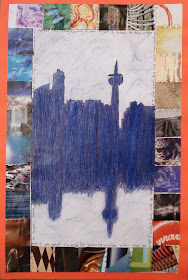I found this lesson, by Art teacher Kris Fontes from Union City High School, on the Incredible
Art Department site and it's since become one of my all-time favourite lessons to teach. I find that all students have a high success rate with this project.
In this project, students create an elegant drawing in the ornamental, decorative and luxurious style of Austrian artist Gustav Klimt. Instead of gold
scratchboard, as used in the original lesson on the IAD site, we simply used gold markers and gel pens on black
paper.
You need fairly simple materials for this: magazines and/or printer, scissors, glue sticks, black paper, and gold pens/markers and books/images of Klimt's work.
I start off by showing a slideshow of Klimt's work and talk a bit about the Art Nouveau movement. Have students describe the patterns and colours used.
From Wikipedia:
Gustav Klimt (1862–1918) was an Austrian Symbolist painter. His
major works include paintings, murals, sketches, and other art objects. Klimt's
primary subject was the female body. He is most famous for his “Golden Phase”
where he used gold leaf in his paintings.
 |
The Kiss, 1907-08
|
"Whoever wants to know something about me – as an artist which alone is significant – they should look attentively at my pictures and there seek to recognize what I am and what I want." (Gustav Klimt)
 |
Adele Bloch-Bauer's Portrait, 1907
(sold for a record $135 million
in 2006)
|
First find a nice large picture in a magazine of a figure that has some flesh showing- a head and arms, or whatever. I told the students to look for lots of photos and then choose the best from the bunch. It does take some time to find just the right image.
Some students wanted a particular person, so they found a photo on the internet and printed it out. The quality wasn't as nice as a magazine photo, though.
Carefully cut out the figure from the background:
Place your figure on the black paper and carefully and lightly trace around it with a pencil.
This is so you'll know where to re-glue the parts in the next step.
Now, cut away all the clothing.
Then glue down, using a glue stick, all the 'flesh' parts. Use your traced guidelines
to help place all the pieces in the right spot.
Now, students are going to design patterns for the clothing and patterns for the background.
One pattern needed to be quite dense and complex, while the other could be simpler, so as to create contrast. Students designed their patterns first in their sketchbooks.
For the good copy, we used two types of gold pens: one thin (Staedtler brand) and a thick one (I bought a bunch from the Dollar store- they were surprisingly good quality I have to say!).
Here are some Grade 9 results:
And some Grade 10 results:























































